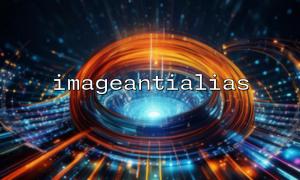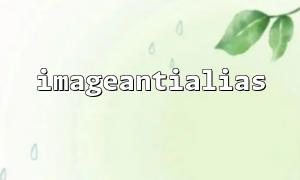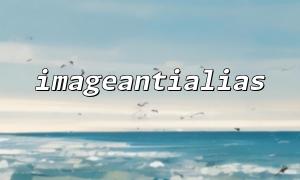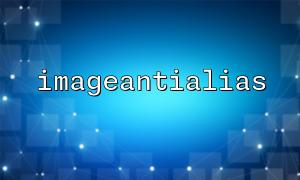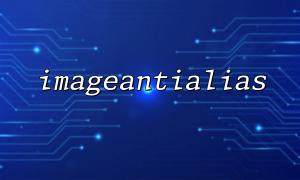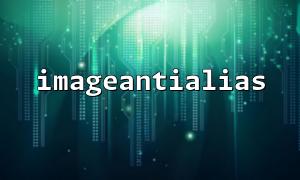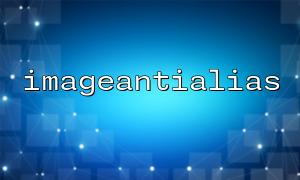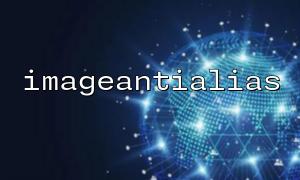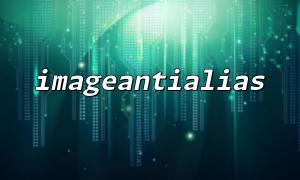When using PHP for image processing, the GD library provides a wealth of functions for developers to call. Among them, imageantialias() is an important function to improve the smoothness of image edges. But in actual projects, imageantialias() is often not used in isolation and is often used in combination with other image filter functions (such as imagefilter() ). So, in this case, will the order of the function call affect the image output effect? The answer is yes.
This article will explore how to reasonably arrange the call order to achieve the best image processing effect when using imageantialias() with other filter functions (such as imagefilter() , imagesmooth() , imagecopyresampled() , etc.).
imageantialias(resource $image, bool $enable): bool
This function is used to turn on or off the anti-aliasing function, mainly acting on the output of lines, arcs or other drawing functions, making the edges of the image smoother.
$image = imagecreatetruecolor(300, 200);
imageantialias($image, true); // Turn on anti-aliasing
Note: imageantialias() is only valid for certain drawing functions, such as imageline() , imagepolygon() , etc., and has no direct impact on image scaling or filtering.
imagefilter() provides a variety of filter options, such as blur, contrast adjustment, sharpening, grayscale, etc., which are usually used to process images that have been generated.
imagefilter($image, IMG_FILTER_GAUSSIAN_BLUR);
This is the recommended approach. If you need to draw a graph and use anti-aliasing effects, you should enable imageantialias() first and then call the drawing function.
$image = imagecreatetruecolor(300, 200);
imageantialias($image, true);
imageline($image, 0, 0, 300, 200, imagecolorallocate($image, 255, 0, 0));
This order ensures that the lines have smoother edges.
The filter function acts on the existing image content. Therefore, imagefilter() should be called after the drawing is completed, otherwise it may have an unexpected impact on the intermediate drawing process.
// Correct order
$image = imagecreatetruecolor(300, 200);
imageantialias($image, true);
imagerectangle($image, 50, 50, 250, 150, imagecolorallocate($image, 0, 255, 0));
imagefilter($image, IMG_FILTER_GAUSSIAN_BLUR);
If the filter function is called before drawing, it will process a blank image, and the filter effect can no longer be superimposed after drawing.
imagecopyresampled() will regenerate image pixel information, so its call order is also critical. Usually recommended:
If you want to filter the zoomed image, you should first scale and then filter;
If you do a complex drawing before scaling, you should use imageantialias() after drawing and before scaling.
$src = imagecreatefromjpeg('https://m66.net/images/sample.jpg');
$dst = imagecreatetruecolor(100, 100);
imagecopyresampled($dst, $src, 0, 0, 0, 0, 100, 100, imagesx($src), imagesy($src));
imagefilter($dst, IMG_FILTER_CONTRAST, -10);
Here is a recommended image processing flow:
$image = imagecreatetruecolor(300, 200);
// 1. Enable anti-aliasing
imageantialias($image, true);
// 2. Drawing
imageline($image, 0, 0, 300, 200, imagecolorallocate($image, 0, 0, 255));
imageellipse($image, 150, 100, 200, 100, imagecolorallocate($image, 255, 0, 0));
// 3. Apply filters
imagefilter($image, IMG_FILTER_SMOOTH, 6);
// 4. Zoom or save
$thumb = imagecreatetruecolor(150, 100);
imagecopyresampled($thumb, $image, 0, 0, 0, 0, 150, 100, 300, 200);
imagejpeg($thumb, '/var/www/html/output.jpg');
imageantialias() needs to be called before the drawing function;
imagefilter() should be used after image drawing;
imagecopyresampled() should be used after all processing is finished;
The order of call of image processing directly determines the quality of the final output.
Understanding the execution order of image processing functions and reasonably scheduling calls can effectively improve the quality and performance of PHP image processing. For complex image operations, you can also consider combining text drawing functions such as imagettftext() to achieve more diverse effects.
If you encounter poor image processing quality in your deployment environment, you might as well revisit your function call order, and you can often get unexpected improvements after adjustments.
